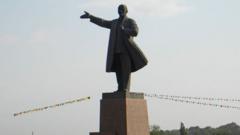In a notable development, Kyrgyzstan has removed a monumental statue of Vladimir Lenin, previously regarded as Central Asia's tallest, from its prominent position in Osh. Erected during the era of the Soviet Union, this 23-meter statue had dominated the city's skyline for half a century before its recent dismantling. New photographs unveiled on Saturday depict the fallen figure of Lenin, once a symbol of Soviet ideology, lying on the ground after being lowered by a crane.
This act signifies Kyrgyzstan's ongoing efforts to reshape its national narrative, distancing itself from its Soviet past, amid a broader regional trend among former Soviet republics. Despite these intentions, local officials have downplayed the significance of the statue's removal, emphasizing that the action aligns with common practices intended to enhance the urban “architectural and aesthetic appearance” of the city.
Kyrgyz authorities remain mindful of the geopolitical implications of their actions, particularly in relation to Russia, a key ally. This is highlighted by the recent unveiling of a new statue of Josef Stalin in Moscow, accentuating the delicate balance that Kyrgyzstan must navigate in its relations with the Kremlin.
City Hall in Osh has indicated plans to replace the statue with a flagpole, mirroring the removal process of another Lenin statue from the capital, Bishkek. Such changes not only mark a shift in public art policy but also reflect the nation's evolving identity since attaining independence from the Soviet Union in 1991.
While remnants of Soviet influence persist in various aspects of Kyrgyz culture and geography—evidenced by landmarks such as Lenin Peak—the removal of the statue encapsulates a pivotal moment in redefining the nation's historical legacy as it continues to navigate its post-Soviet identity.



















